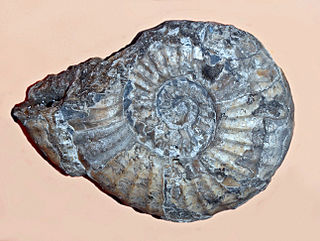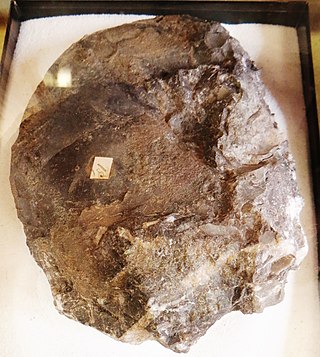
The Nautilida constitute a large and diverse order of generally coiled nautiloid cephalopods that began in the mid Paleozoic and continues to the present with a single family, the Nautilidae which includes two genera, Nautilus and Allonautilus, with six species. All told, between 22 and 34 families and 165 to 184 genera have been recognised, making this the largest order of the subclass Nautiloidea.

Cassinoceras is a genus of nautiloids belonging to the endocerid family Piloceratidae that comes from the late Early Ordovician of eastern North America and adjacent territories.

Acanthoceratidae is an extinct family of acanthoceratoid cephalopods in the order Ammonitida, known from the Upper Cretaceous. The type genus is Acanthoceras.

Medlicottiidae is a family of ammonoid cephalopods belonging to the Prolecanitida, known from the Upper Carboniferous (Pennsylvanian) to the Early Triassic.

Slender Oncoceratidae are those in the family Oncoceratidae, which have slender, commonly curved, shells. Some like Oocerina are gently curved, almost straight, and with only slight expansion. Others like Dunleithoceras are strongly curved with a more notable rate of expansion. Inclusion in this somewhat arbitrary category is based on illustrations in the Treatise Part K, 1964.

Psiloceratoidea is a superfamily of Early Jurassic ammonoid cephalopods proposed by Hyatt in 1867, assigned to the order Ammonitida. They were very successful during Hettangian and Sinemurian. Last of them, family Cymbitidae and genera Hypoxynoticeras and Radstockiceras survived into Early Pliensbachian.
Bickmorites is an extinct nautiloid cephalopod genus known from the upper Ordovician to the middle Silurian of North America and northern Europe (Norway).
Uranoceras is a barrandeocerid genus from the Middle Silurian belonging to the family Uranoceratidae, characterized by its loosely coiled, gyroconic shell of 1.5 to 2 subquadrate whorls.
Westonoceras is an extinct nautiloid genus from the Discosorida that lived during the Middle and Late Ordovician that has been found in North America, Greenland, and Northern Europe. It is the type genus for the Westonoceratidae

The Trigonoceratoidea are a superfamily within the Nautilida that ranged from the Devonian to the Triassic, thought to have contained the source for the Nautilaceae in which Nautilus is found.
The Tripteroceratidae is a family of depressed, straight to slightly curved nautiloid cephalopods from the middle and upper Ordovician with generally flattened venters and empty siphuncles with straight to inflated segments included in the Oncocerida.
The Trigonoceratidae is a family of coiled nautiloid cephalopods that lived during the period from the Early Carboniferous (Mississippian) to the Early Permian.

Clymeniida is an order of ammonoid cephalopods from the Upper Devonian characterized by having an unusual dorsal siphuncle. They measured about 4 cm (1.6 in) in diameter and are most common in Europe, North Africa, and South China but are known from North America and Australia as well.

The Barrandeoceratidae is a family of coiled nautiloids included in the Tarphycerida that lived from the Middle Ordovician to the Middle Devonian, characterised by mostly compressed shells with a subcentral siphuncle composed of thin-walled segments that may become secondarily ventral.(Flower and Kummel 1950, Sweet 1964).
The genus Savageoceras is a barrandeoceratid first known from the Middle Silurian of Illinois consisting of rapidly enlarging, depressed cyrtocones with a trapezoidal section; ventral side wider and flatter than dorsal; sides converging on dorsum. Sutures have slight lateral and ventral lobes and ventrolateral saddles. The surface is covered by transverse striae and has rib-like rings that are more prominent at the ventrolateral shoulders but otherwise vaguely defined. The siphuncle is central; interior unknown.

Gymnites is a genus of ammonoid cephalopod from the Middle Triassic belonging to the ceratitid family Gymnitidae. These nektonic carnivores lived during the Triassic period, the Anisian age.
The Apsidoceratidae is a family of Middle and Upper Ordovician Barrandeocerina,, characterized by curved or coiled, smooth, transversely marked, or laterally costate shells, with a conspicuous hyponomic sinus. Early whorl sections tend to be subtriangular; become broader and dorsally impressed in closely coiled forms. Sutures are with lateral lobes in primitive forms but are without lateral lobes, but with ventral lobes in more advanced species with broader sections. Siphuncles are between the center and ventral margin, but not close to either.
Plectoceras is a genus of nautiloids included in the tarphycerid suborder Barrandeocerina that lived during the Middle and Late Ordovician. It has been found widespread in the Middle and Upper Ordovician of North America.
Grimsbyoceras is a nautiloid genus included in the Oncocerida order of the family Acleistoceratidae that lived during the Middle Devonian. They have been found in North America (Illinois) and central Europe.
Charactoceras is a tarphycerid genus cephalopod which lived during the Late Ordovician.










